Investigating the Microstructural and Mechanical Properties of Novel Ternary Reinforced AA7075 Hybrid Metal Matrix Composite
Abstract
:1. Introduction
2. Materials and Methods
2.1. Materials
2.2. Sample Preparation
Heat Treatment
2.3. Characterization and Mechanical Testing
2.3.1. Scanning Electron Microscopy and Energy Dispersive Spectroscopy
2.3.2. Density and Porosity
2.3.3. Tensile Test
2.3.4. Hardness Test
2.3.5. Impact Test
3. Results and Discussion
3.1. Density and Porosity
3.2. Microstructural Examination
3.3. Mechanical Properties
3.3.1. Tensile Properties
3.3.2. Hardness
3.3.3. Impact Strength
4. Conclusions
- The highest ultimate tensile strength of 289 MPa was obtained for n-HMMC (AA7075-5wt %SiC-3wt %RHA-1wt %CES), which was 24.4%, 12.8%, and 6.6% higher than the base alloy, MMC and s-HMMC, respectively;
- The highest hardness of RH = 81.2 was recorded for n-HMMC, which was 32.83%, 29.23%, and 14.9% higher than the base alloy, MMC, and s-HMMC, respectively;
- The density of the n-HMMC was 1.18% less than the density of the base alloy, which has an experimental density of 2769 kg/m3. Consequently, among all the samples, n-HMMC has the highest porosity of 3.25% due to improper mixing of reinforcements and matrix, wettability issues, agglomerations, and pouring defects;
- The highest %EL of 10.4% was observed in s-HMMC (AA7075-5wt %SiC-3wt %RHA). On the other hand, n-HMMC has the least ductility at 5.98%. The reduction in ductility is due to the dominating effect of the ceramic particles’ dispersion over the reinforcement-induced grain refinement effect;
- MMC and s-HMMC showed a greater increase in the impact energy of about 106% and 214%, respectively, as compared to the base alloy. However, a marginal increase of 8.6% was observed in the impact energy of the n-HMMC. The drop in impact strength with the addition of tertiary reinforcement (1wt % CES) was due to the non-uniform distribution of reinforcements, wettability issues, and the formation of the agglomerates;
- EDS analysis confirmed the presence of the respective elements of the reinforcements in bulk for the successful preparation of samples through the stir casting process. SEM analysis shows the relatively uniform distribution of the reinforcing particles in the MMC and s-HMMC. However, higher agglomerates are observed in the n-HMMC due to the increase in the ceramic content and mixing issues. These agglomerates serve as the potential site of stress concentration, compromising the ductility and impact strength;
- Though stir casting is one of the commonly used processes for fabricating MMCs and HMMCs; however, more controlled process parameters are required to avoid mixing issues, agglomerates, and oxides formation. Therefore, it is recommended to develop the same n-HMMC with different fabrication techniques to address the aforementioned shortcomings of the stir casting technique, if possible;
- In the future, the findings of this research could be used for practical applications in aerospace, automobile, defense, and marine industry for which its processibility, machining, and in-service capabilities are required for further investigations.
Author Contributions
Funding
Institutional Review Board Statement
Informed Consent Statement
Data Availability Statement
Conflicts of Interest
References
- Das, D.K.; Mishra, P.C.; Singh, S.; Pattanaik, S. Fabrication and heat treatment of ceramic-reinforced aluminium matrix composites—A review. Int. J. Mech. Mater. Eng. 2014, 9, 6. [Google Scholar] [CrossRef] [Green Version]
- Hao, S.; Xie, J. Tensile properties and strengthening mechanisms of SiCp-reinforced aluminum matrix composites as a function of relative particle size ratio. J. Mater. Res. 2013, 28, 2047–2055. [Google Scholar] [CrossRef]
- Sajjadi, S.A.; Ezatpour, H.R.; Beygi, H. Microstructure and mechanical properties of Al–Al2O3 micro and nano composites fabricated by stir casting. Mater. Sci. Eng. A 2011, 528, 8765–8771. [Google Scholar] [CrossRef]
- Rajan, T.P.D.; Pillai, R.M.; Pai, B.C. Characterization of centrifugal cast functionally graded aluminum-silicon carbide metal matrix composites. Mater. Charact. 2010, 61, 923–928. [Google Scholar] [CrossRef]
- Miller, W.S.; Zhuang, L.; Bottema, J.; Wittebrood, A.J.; De Smet, P.; Haszler, A.; Vieregge, A. Recent development in aluminium alloys for the automotive industry. Mater. Sci. Eng. A 2000, 280, 37–49. [Google Scholar] [CrossRef]
- Shi, R.; Meier, J.M.; Luo, A.A. Controlling Particle/Metal Interactions in Metal Matrix Composites During Solidification: The Role of Melt Viscosity and Cooling Rate. Metall. Mater. Trans. A 2019, 50, 3736–3747. [Google Scholar] [CrossRef]
- Kala, H.; Mer, K.K.S.; Kumar, S. A Review on Mechanical and Tribological Behaviors of Stir Cast Aluminum Matrix Composites. Procedia Mater. Sci. 2014, 6, 1951–1960. [Google Scholar] [CrossRef] [Green Version]
- Lu, H.X.; Hu, J.; Chen, C.P.; Sun, H.W.; Hu, X.; Yang, D.L. Characterization of Al2O3–Al nano-composite powder prepared by a wet chemical method. Ceram. Int. 2005, 31, 481–485. [Google Scholar] [CrossRef]
- Baradeswaran, A.; Elaya Perumal, A. Influence of B4C on the tribological and mechanical properties of Al 7075–B4C composites. Compos. Part B Eng. 2013, 54, 146–152. [Google Scholar] [CrossRef]
- Bhushan, R.K.; Kumar, S.; Das, S. Fabrication and characterization of 7075 Al alloy reinforced with SiC particulates. Int. J. Adv. Manuf. Technol. 2013, 65, 611–624. [Google Scholar] [CrossRef]
- Bhoi, N.K.; Singh, H.; Pratap, S. Developments in the aluminum metal matrix composites reinforced by micro/nano particles—A review. J. Compos. Mater. 2019, 54, 813–833. [Google Scholar] [CrossRef]
- Garg, P.; Jamwal, A.; Kumar, D.; Sadasivuni, K.K.; Hussain, C.M.; Gupta, P. Advance research progresses in aluminium matrix composites: Manufacturing & applications. J. Mater. Res. Technol. 2019, 8, 4924–4939. [Google Scholar] [CrossRef]
- Singh, L.; Singh, B.; Saxena, K.K. Manufacturing techniques for metal matrix composites (MMC): An overview. Adv. Mater. Process. Technol. 2020, 6, 441–457. [Google Scholar] [CrossRef]
- Sharma, D.K.; Badheka, V.; Patel, V.; Upadhyay, G. Recent Developments in Hybrid Surface Metal Matrix Composites Produced by Friction Stir Processing: A Review. J. Tribol. 2021, 143, 050801. [Google Scholar] [CrossRef]
- Joseph, O.O.; Babaremu, K.O. Agricultural Waste as a Reinforcement Particulate for Aluminum Metal Matrix Composite (AMMCs): A Review. Fibers 2019, 7, 33. [Google Scholar] [CrossRef] [Green Version]
- Bodunrin, M.O.; Alaneme, K.K.; Chown, L.H. Aluminium matrix hybrid composites: A review of reinforcement philosophies; mechanical, corrosion and tribological characteristics. J. Mater. Res. Technol. 2015, 4, 434–445. [Google Scholar] [CrossRef] [Green Version]
- Kanayo Alaneme, K.; Apata Olubambi, P. Corrosion and wear behaviour of rice husk ash—Alumina reinforced Al–Mg–Si alloy matrix hybrid composites. J. Mater. Res. Technol. 2013, 2, 188–194. [Google Scholar] [CrossRef] [Green Version]
- Kannan, C.; Ramanujam, R. Comparative study on the mechanical and microstructural characterisation of AA 7075 nano and hybrid nanocomposites produced by stir and squeeze casting. J. Adv. Res. 2017, 8, 309–319. [Google Scholar] [CrossRef]
- Zhou, M.Y.; Ren, L.B.; Fan, L.L.; Zhang, Y.W.X.; Lu, T.H.; Quan, G.F.; Gupta, M. Progress in research on hybrid metal matrix composites. J. Alloys Compd. 2020, 838, 155274. [Google Scholar] [CrossRef]
- Aamir, M.; Giasin, K.; Tolouei-Rad, M.; Vafadar, A. A review: Drilling performance and hole quality of aluminium alloys for aerospace applications. J. Mater. Res. Technol. 2020, 9, 12484–12500. [Google Scholar] [CrossRef]
- Habib, N.; Sharif, A.; Hussain, A.; Aamir, M.; Giasin, K.; Pimenov, D.Y.; Ali, U. Analysis of hole quality and chips formation in the dry drilling process of Al7075-T6. Metals 2021, 11, 891. [Google Scholar] [CrossRef]
- Bertolini, R.; Simonetto, E.; Pezzato, L.; Fabrizi, A.; Ghiotti, A.; Bruschi, S. Mechanical and corrosion resistance properties of AA7075-T6 sub-zero formed sheets. Int. J. Adv. Manuf. Technol. 2021, 115, 2801–2824. [Google Scholar] [CrossRef]
- Veeravalli, R.R.; Nallu, R.; Mohammed Moulana Mohiuddin, S. Mechanical and tribological properties of AA7075–TiC metal matrix composites under heat treated (T6) and cast conditions. J. Mater. Res. Technol. 2016, 5, 377–383. [Google Scholar] [CrossRef] [Green Version]
- Ramkumar, K.R.; Sivasankaran, S.; Al-Mufadi, F.A.; Siddharth, S.; Raghu, R. Investigations on microstructure, mechanical, and tribological behaviour of AA 7075-x wt.% TiC composites for aerospace applications. Arch. Civ. Mech. Eng. 2019, 19, 428–438. [Google Scholar] [CrossRef]
- Wu, C.; Ma, K.; Wu, J.; Fang, P.; Luo, G.; Chen, F.; Shen, Q.; Zhang, L.; Schoenung, J.M.; Lavernia, E.J. Influence of particle size and spatial distribution of B4C reinforcement on the microstructure and mechanical behavior of precipitation strengthened Al alloy matrix composites. Mater. Sci. Eng. A 2016, 675, 421–430. [Google Scholar] [CrossRef]
- Baradeswaran, A.; Vettivel, S.C.; Elaya Perumal, A.; Selvakumar, N.; Issac, R.F. Experimental investigation on mechanical behaviour, modelling and optimization of wear parameters of B4C and graphite reinforced aluminium hybrid composites. Mater. Des. 2014, 63, 620–632. [Google Scholar] [CrossRef]
- Kumar, H.; Prasad, R.; Kumar, P.; Tewari, S.P.; Singh, J.K. Mechanical and tribological characterization of industrial wastes reinforced aluminum alloy composites fabricated via friction stir processing. J. Alloys Compd. 2020, 831, 154832. [Google Scholar] [CrossRef]
- Chechi, P.; Maurya, S.K.; Prasad, R.; Manna, A. Microstructural and mechanical characterization of stir cast Al-SiC/Flyash/Graphite hybrid metal matrix composite. Mater. Today Proc. 2022, 64, 637–642. [Google Scholar] [CrossRef]
- Arora, G.; Sharma, S. A Comparative Study of AA6351 Mono-Composites Reinforced with Synthetic and Agro Waste Reinforcement. Int. J. Precis. Eng. Manuf. 2018, 19, 631–638. [Google Scholar] [CrossRef]
- Singh, P.; Mishra, R.K.; Singh, B. Microstructural and mechanical characterization of lamb bone ash and boron carbide reinforced ZA-27 hybrid metal matrix composites. Proc. Inst. Mech. Eng. Part L J. Mater. Des. Appl. 2021, 235, 2516–2530. [Google Scholar] [CrossRef]
- Tejyan, S.; Ror, C.K.; Kumar, N. Mechanical properties of SiC and neem leaf powder reinforced Al-6063 hybrid metal matrix composites. Mater. Today Proc. 2022, 60, 884–888. [Google Scholar] [CrossRef]
- Manikandan, R.; Arjunan, T.V. Studies on micro structural characteristics, mechanical and tribological behaviours of boron carbide and cow dung ash reinforced aluminium (Al 7075) hybrid metal matrix composite. Compos. Part B Eng. 2020, 183, 107668. [Google Scholar] [CrossRef]
- Gupta, R.; Sharma, S.; Nanda, T.; Pandey, O.P. Wear studies of hybrid AMCs reinforced with naturally occurring sillimanite and rutile ceramic particles for brake-rotor applications. Ceram. Int. 2020, 46, 16849–16859. [Google Scholar] [CrossRef]
- Tan, D.; Xia, S.; Yob, A.; Yang, K.; Yan, S.; Givord, M.; Liang, D. Evaluation of the wear resistance of aluminium-based hybrid composite brake discs under relevant city rail environments. Mater. Des. 2022, 215, 110504. [Google Scholar] [CrossRef]
- Sharma, D.K.; Mahant, D.; Upadhyay, G. Manufacturing of metal matrix composites: A state of review. Mater. Today Proc. 2020, 26, 506–519. [Google Scholar] [CrossRef]
- Dhanesh, S.; Kumar, K.S.; Fayiz, N.K.M.; Yohannan, L.; Sujith, R. Recent developments in hybrid aluminium metal matrix composites: A review. Mater. Today Proc. 2021, 45, 1376–1381. [Google Scholar] [CrossRef]
- yadav, R.; Dwivedi, V.K.; Dwivedi, S.P. Eggshell and rice husk ash utilization as reinforcement in development of composite material: A review. Mater. Today Proc. 2021, 43, 426–433. [Google Scholar] [CrossRef]
- Dixit, P.; Suhane, A. Aluminum metal matrix composites reinforced with rice husk ash: A review. Mater. Today Proc. 2022, 62, 4194–4201. [Google Scholar] [CrossRef]
- Seetharaman, S.; Subramanian, J.; Singh, R.A.; Wong, W.L.; Nai, M.L.; Gupta, M. Mechanical Properties of Sustainable Metal Matrix Composites: A Review on the Role of Green Reinforcements and Processing Methods. Technologies 2022, 10, 32. [Google Scholar] [CrossRef]
- Feng, Y.; Ashok, B.; Madhukar, K.; Zhang, J.; Zhang, J.; Reddy, K.O.; Rajulu, A.V. Preparation and Characterization of Polypropylene Carbonate Bio-Filler (Eggshell Powder) Composite Films. Int. J. Polym. Anal. Charact. 2014, 19, 637–647. [Google Scholar] [CrossRef]
- Verma, N.; Vettivel, S.C. Characterization and experimental analysis of boron carbide and rice husk ash reinforced AA7075 aluminium alloy hybrid composite. J. Alloys Compd. 2018, 741, 981–998. [Google Scholar] [CrossRef]
- Alaneme, K.K.; Sanusi, K.O. Microstructural characteristics, mechanical and wear behaviour of aluminium matrix hybrid composites reinforced with alumina, rice husk ash and graphite. Eng. Sci. Technol. Int. J. 2015, 18, 416–422. [Google Scholar] [CrossRef] [Green Version]
- Al-Alwan, A.A.K.; Al-Bazoon, M.; Mussa, F.I.; Alalwan, H.A.; Hatem Shadhar, M.; Mohammed, M.M.; Mohammed, M.F. The impact of using rice husk ash as a replacement material in concrete: An experimental study. J. King Saud Univ. Eng. Sci. 2022. [Google Scholar] [CrossRef]
- Zaid, O.; Ahmad, J.; Siddique, M.S.; Aslam, F. Effect of Incorporation of Rice Husk Ash Instead of Cement on the Performance of Steel Fibers Reinforced Concrete. Front. Mater. 2021, 8, 151. [Google Scholar] [CrossRef]
- Hossain, S.S.; Mathur, L.; Roy, P.K. Rice husk/rice husk ash as an alternative source of silica in ceramics: A review. J. Asian Ceram. Soc. 2018, 6, 299–313. [Google Scholar] [CrossRef]
- Jongpradist, P.; Homtragoon, W.; Sukkarak, R.; Kongkitkul, W.; Jamsawang, P. Efficiency of Rice Husk Ash as Cementitious Material in High-Strength Cement-Admixed Clay. Adv. Civ. Eng. 2018, 2018, 8346319. [Google Scholar] [CrossRef]
- Arunkumar, S.; Kumar, A.S. Studies on Egg Shell and SiC Reinforced Hybrid Metal Matrix Composite for Tribological Applications. Silicon 2022, 14, 1959–1967. [Google Scholar] [CrossRef]
- Singh, P.; Mishra, R.K.; Singh, B. Mechanical characterization of eggshell ash and boron carbide reinforced ZA-27 hybrid metal matrix composites. Proc. Inst. Mech. Eng. Part C J. Mech. Eng. Sci. 2021, 236, 1766–1779. [Google Scholar] [CrossRef]
- Mohamad, Z.; Daud, M.F.A. Effect of Eggshell Waste as Reinforcement on Physical and Mechanical Properties of Recycled Aluminium Chip AA7075: A Review. Res. Prog. Mech. Manuf. Eng. 2020, 1, 107–114. [Google Scholar]
- Gupta, V.; Singh, B.; Mishra, R.K. Tribological characteristics of AA7075 composites reinforced with rice husk ash and carbonized eggshells. Proc. Inst. Mech. Eng. Part L J. Mater. Des. Appl. 2021, 235, 2600–2613. [Google Scholar] [CrossRef]
- Alengaram, U.J. 2—Valorization of industrial byproducts and wastes as sustainable construction materials. In Handbook of Sustainable Concrete and Industrial Waste Management; Colangelo, F., Cioffi, R., Farina, I., Eds.; Woodhead Publishing: Sawston, UK, 2022; pp. 23–43. [Google Scholar] [CrossRef]
- Sharma, S.; Singh, J.; Gupta, M.K.; Mia, M.; Dwivedi, S.P.; Saxena, A.; Chattopadhyaya, S.; Singh, R.; Pimenov, D.Y.; Korkmaz, M.E. Investigation on mechanical, tribological and microstructural properties of Al–Mg–Si–T6/SiC/muscovite-hybrid metal-matrix composites for high strength applications. J. Mater. Res. Technol. 2021, 12, 1564–1581. [Google Scholar] [CrossRef]
- ASTM Standard B962-13; Standard Test Methods for Density of Compacted or Sintered Powder Metallurgy (PM) Products Using Archimedes’ Principle. ASTM International: West Conshohocken, PA, USA, 2013. [CrossRef]
- ASTM Standard B557-15; Standard Test Methods for Tension Testing Wrought and Cast Aluminum- and Magnesium-Alloy Products. ASTM International: West Conshohocken, PA, USA, 2015. [CrossRef]
- ASTM Standard E18-20; Standard Test Methods for Rockwell Hardness of Metallic Materials. ASTM International: West Conshohocken, PA, USA, 2022. [CrossRef]
- ASTM Standard E10-18; Standard Test Method for Brinell Hardness of Metallic Materials. ASTM International: West Conshohocken, PA, USA, 2018. [CrossRef]
- ASTM Standard E23-16; Standard Test Methods for Notched Bar Impact Testing of Metallic Materials. ASTM International: West Conshohocken, PA, USA, 2016. [CrossRef]
- Manikandan, R.; Arjunan, T.V. Microstructure and Mechanical Characteristics of CDA–B4C Hybrid Metal Matrix Composites. Met. Mater. Int. 2021, 27, 885–899. [Google Scholar] [CrossRef]
- Sahoo, B.P.; Das, D.; Chaubey, A.K. Strengthening mechanisms and modelling of mechanical properties of submicron-TiB2 particulate reinforced Al 7075 metal matrix composites. Mater. Sci. Eng. A 2021, 825, 141873. [Google Scholar] [CrossRef]
- Malaki, M.; Fadaei Tehrani, A.; Niroumand, B.; Gupta, M. Wettability in Metal Matrix Composites. Metals 2021, 11, 1034. [Google Scholar] [CrossRef]
- Arun Kumar, S.; Hari Vignesh, J.; Paul Joshua, S. Investigating the effect of porosity on aluminium 7075 alloy reinforced with silicon nitride (Si3N4) metal matrix composites through STIR casting process. Mater. Today Proc. 2021, 39, 414–419. [Google Scholar] [CrossRef]
- Kerti, I.; Toptan, F. Microstructural variations in cast B4C-reinforced aluminium matrix composites (AMCs). Mater. Lett. 2008, 62, 1215–1218. [Google Scholar] [CrossRef]
- Prabu, S.B.; Karunamoorthy, L.; Kathiresan, S.; Mohan, B. Influence of stirring speed and stirring time on distribution of particles in cast metal matrix composite. J. Mater. Process. Technol. 2006, 171, 268–273. [Google Scholar] [CrossRef]
- Saravanan, S.D.; Senthilkumar, M.; Shankar, S. Effect of Particle Size on Tribological Behavior of Rice Husk Ash–Reinforced Aluminum Alloy (AlSi10Mg) Matrix Composites. Tribol. Trans. 2013, 56, 1156–1167. [Google Scholar] [CrossRef]
- Ye, T.; Xu, Y.; Ren, J. Effects of SiC particle size on mechanical properties of SiC particle reinforced aluminum metal matrix composite. Mater. Sci. Eng. A 2019, 753, 146–155. [Google Scholar] [CrossRef]
- ASTM Standard E3-11; Standard Guide for Preparation of Metallographic Specimens. ASTM International: West Conshohocken, PA, USA, 2017. [CrossRef]
- Armstrong, R.W. Engineering science aspects of the Hall–Petch relation. Acta Mech. 2014, 225, 1013–1028. [Google Scholar] [CrossRef]
- Novitskaya, E.; Karandikar, K.; Cummings, K.; Mecartney, M.; Graeve, O.A. Hall–Petch effect in binary and ternary alumina / zirconia / spinel composites. J. Mater. Res. Technol. 2021, 11, 823–832. [Google Scholar] [CrossRef]
- Xu, S.S.; Zhao, Y.; Chen, D.; Sun, L.W.; Chen, L.; Tong, X.; Liu, C.T.; Zhang, Z.W. Nanoscale precipitation and its influence on strengthening mechanisms in an ultra-high strength low-carbon steel. Int. J. Plast. 2019, 113, 99–110. [Google Scholar] [CrossRef]
- Jafari, H.; Mansouri, H.; Honarpisheh, M. Investigation of residual stress distribution of dissimilar Al-7075-T6 and Al-6061-T6 in the friction stir welding process strengthened with SiO2 nanoparticles. J. Manuf. Processes 2019, 43, 145–153. [Google Scholar] [CrossRef]
- Kumar, N.S.; Pramod, G.K.; Samrat, P.; Sadashiva, M. A Critical Review on Heat Treatment of Aluminium Alloys. Mater. Today Proc. 2022, 58, 71–79. [Google Scholar] [CrossRef]
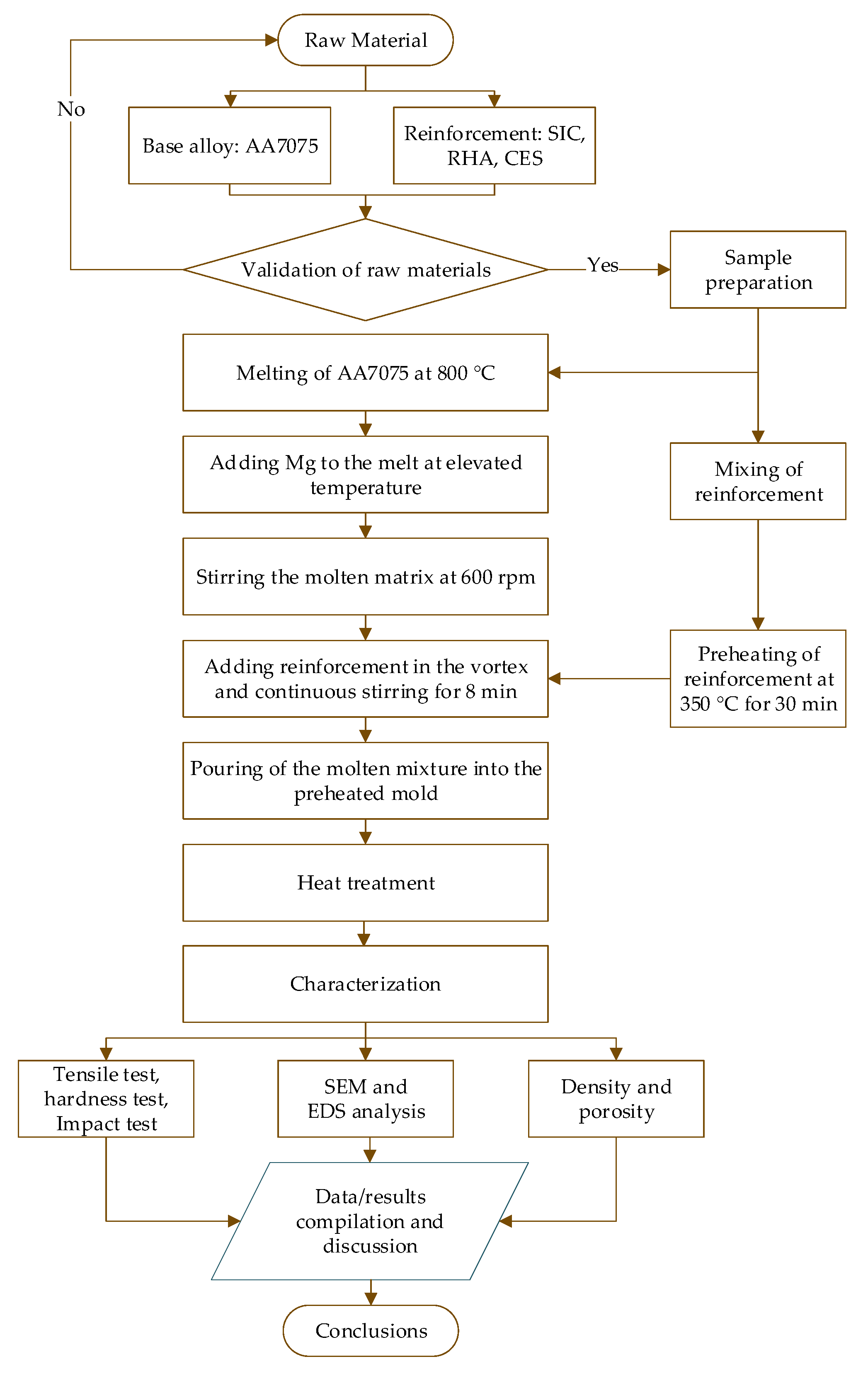


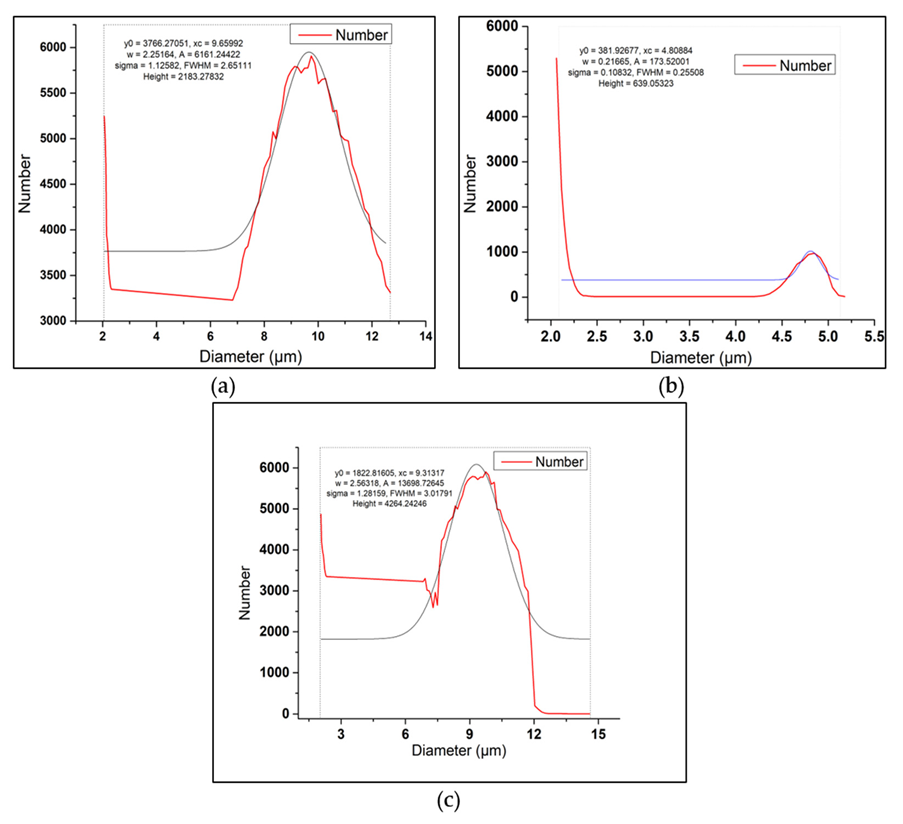


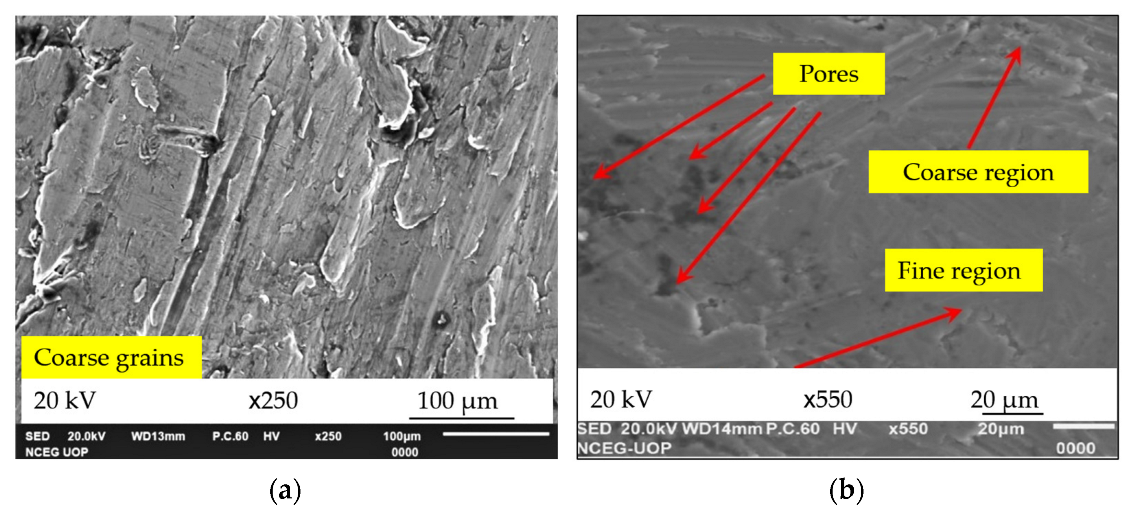

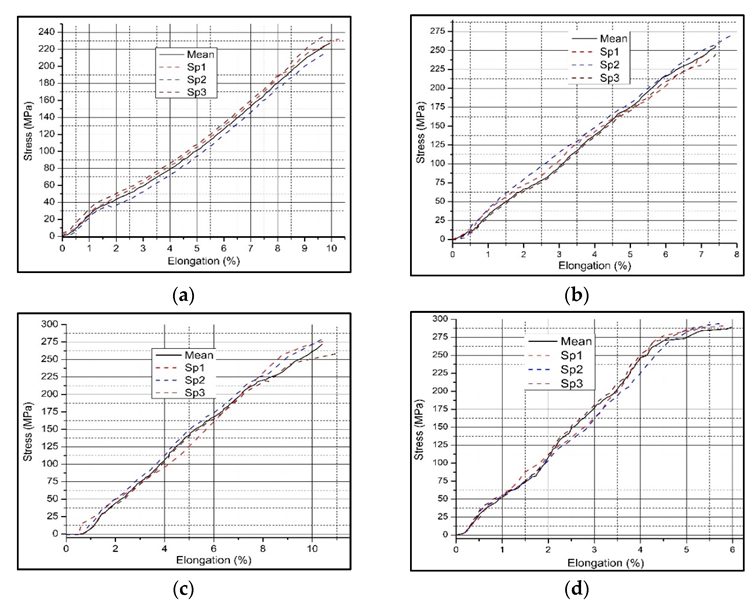

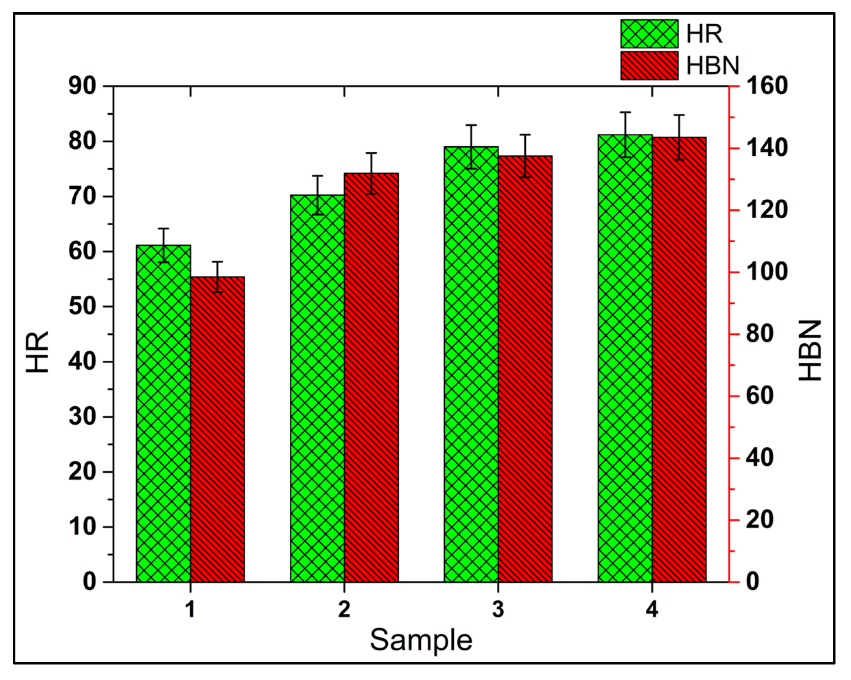
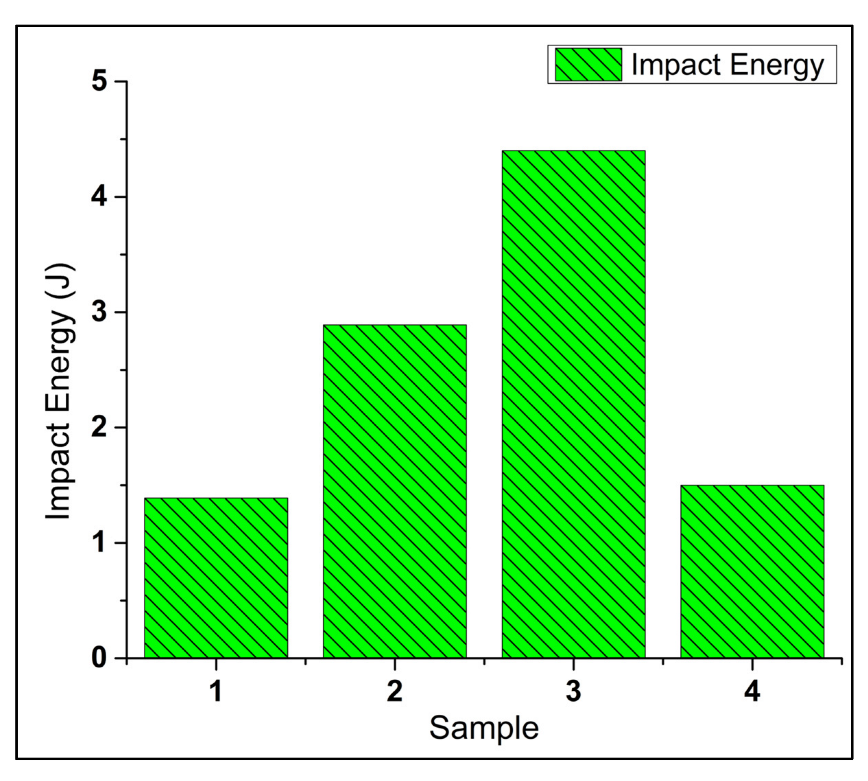
| Sample | Composition (wt %) | ||||
|---|---|---|---|---|---|
| AA7075 | Mg | SiC | RHA | CES | |
| Base Alloy | Filler Material | Primary Reinforcement | Secondary Reinforcement | Tertiary Reinforcement | |
| 1 | 100 | 0 | 0 | 0 | 0 |
| 2 | 94 | 1 | 5 | 0 | 0 |
| 3 | 91 | 1 | 5 | 3 | 0 |
| 4 | 90 | 1 | 5 | 3 | 1 |
Publisher’s Note: MDPI stays neutral with regard to jurisdictional claims in published maps and institutional affiliations. |
© 2022 by the authors. Licensee MDPI, Basel, Switzerland. This article is an open access article distributed under the terms and conditions of the Creative Commons Attribution (CC BY) license (https://creativecommons.org/licenses/by/4.0/).
Share and Cite
Khan, A.H.; Shah, S.A.A.; Umar, F.; Noor, U.; Gul, R.M.; Giasin, K.; Aamir, M. Investigating the Microstructural and Mechanical Properties of Novel Ternary Reinforced AA7075 Hybrid Metal Matrix Composite. Materials 2022, 15, 5303. https://doi.org/10.3390/ma15155303
Khan AH, Shah SAA, Umar F, Noor U, Gul RM, Giasin K, Aamir M. Investigating the Microstructural and Mechanical Properties of Novel Ternary Reinforced AA7075 Hybrid Metal Matrix Composite. Materials. 2022; 15(15):5303. https://doi.org/10.3390/ma15155303
Chicago/Turabian StyleKhan, Afnan Haider, Syed Ahmad Ali Shah, Farheen Umar, Uneeb Noor, Rizwan Mahmood Gul, Khaled Giasin, and Muhammad Aamir. 2022. "Investigating the Microstructural and Mechanical Properties of Novel Ternary Reinforced AA7075 Hybrid Metal Matrix Composite" Materials 15, no. 15: 5303. https://doi.org/10.3390/ma15155303
APA StyleKhan, A. H., Shah, S. A. A., Umar, F., Noor, U., Gul, R. M., Giasin, K., & Aamir, M. (2022). Investigating the Microstructural and Mechanical Properties of Novel Ternary Reinforced AA7075 Hybrid Metal Matrix Composite. Materials, 15(15), 5303. https://doi.org/10.3390/ma15155303










